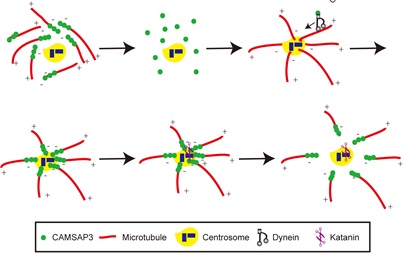Microtubules (MTs) are a prominent component of the cytoskeleton and participate in many important cellular processes such as cell division, migration and polarity. Two kinds of MTs, centrosomal and noncentrosomal, exist in animal cells. In polarized epithelial cells, MTs are arranged along the apicobasal axis of the cell with minus-ends oriented apically and plus-ends basally. How these noncentrosomal MTs are formed, however, remains largely unknown. It has been previously proposed that a release-and-capture mechanism is mainly responsible for the generation of noncentrosomal apico-basal MTs arrays in epithelial cells. However, the molecular mechanism is largely unknown.
In a recent study, researchers from MENG Wenxiang group at the Institute of Genetics and Developmental Biology, Chinese Academy of Sciences, found that Nezha, also called CAMSAP3 (calmodulin-regulated spectrin-associated protein 3), showed high dynamics in the pericentrosomal area and played a key role in the regulation of microtubules array.
Nezha/ CAMSAP3, is the most important protein that has been firstly identified locating at the minus-end of noncentrosomal microtubules, named after an artist's depiction of the Chinese mythological figure Nezha. MENG’s group found that dynein activity was responsible for Nezha/CAMSAP3 accumulation. They further found that Nezha/CAMSAP3 promoted MTs release from the centrosome and katanin p60 might be involved in it. Their results showed that Nezha/ CAMSAP3 and katanin p60 could coordinate to help MTs release from the centrosome in epithelial cells.
This study has proposed a novel mechanism for the regulation of the radial or non-radial organization of the MTs array.
This work, entitled “CAMSAP3 Accumulates in the Pericentrosomal Area and Accompanies Microtubules Release from the Centrosome via Katanin”, has been published on
Journal of Cell Science (
J Cell Sci 2017, 130: 1709-1715; doi: 10.1242/jcs.198010) with PhD candidate DONG Congcongg as first authors.
This work was supported by the National Natural Science Foundation of China, the National Basic Research Program of China, and the Key Research Program of the Chinese Academy of Sciences.
`

Hypothesis model for how CAMSAP3, dynein and katanin p60 coordinate with each other to aid microtubule release from the centrosome. (Image by IGDB)
May 15, 2017; 130 (10)
Cover: An artist’s rendition of the Chinese mythical creature Nezha (CAMSAP3) holding a fire-tipped spear (katanin p60) in his right hand to conquer (cut) the dragon king (microtubules). (Image by SHEN Guangwei)
Contact:
Dr. MENG Wenxiang



